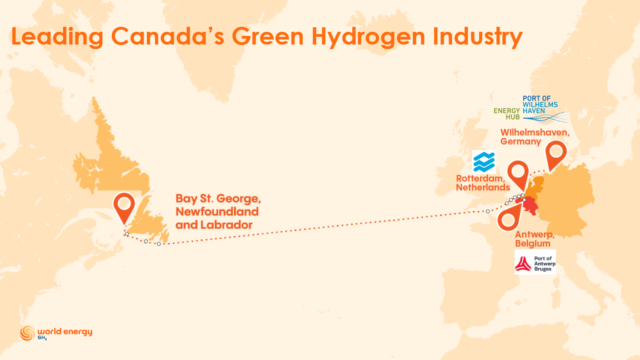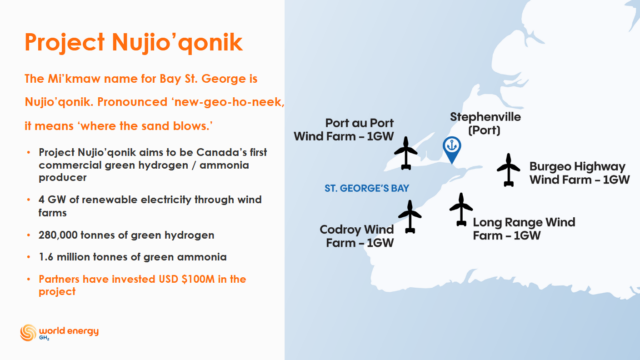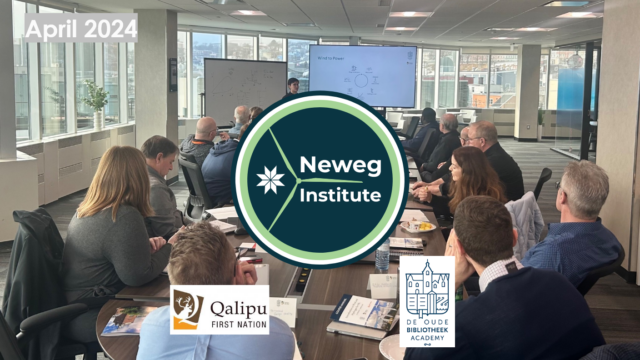Harnessing wind power for ammonia on Canada’s Atlantic coast
By Kevin Rouwenhorst on July 12, 2024
In our June episode of Project Features, Sean Leet and Greg Heath from World Energy GH2 joined us to discuss Project Nujio’qonik, a renewable ammonia project based on wind in Newfoundland and Labrador, Canada. The recording is available on the AEA’s website, and you can also download the speaker presentations.
The Canada-Europe Corridor
Canada has various fossil-fueled ammonia plants, totaling over 4 million tons per year of production capacity. Most of this capacity is in Alberta, with the two other plants in Manitoba and Saskatchewan. These are all landlocked provinces toward the middle and western parts of Canada, meaning that significant inland transport of ammonia already occurs in Canada, mainly by rail.
On Canada’s east coast, the provinces of Newfoundland & Labrador and Nova Scotia have significant wind potential. Wind speeds in excess of 10 meters per second on average are reported on the west coast of the island of Newfoundland, with net capacity factors that can exceed 50%. This would allow for electrolytic hydrogen facilities to operate at a relatively high load factor, especially when some renewable-based grid support is available. This renewable hydrogen can then be converted into ammonia for transport across the Atlantic Ocean to Europe, which will have significant renewable hydrogen and ammonia demand by the late 2020s. Various renewable ammonia projects have been announced in Newfoundland & Labrador and Nova Scotia to meet this demand.

Click to enlarge. The Canada-Europe Corridor. From Sean Leet and Greg Heath, Harnessing Newfoundland and Labrador’s vast wind and water for global green hydrogen and ammonia markets (June 2024).
The potential for exporting renewable energy from Canada to Europe in the form of ammonia was discussed in 2018, during a trade mission between Canada and the Netherlands. In August 2022, the Canada-Germany Hydrogen Alliance was signed at the Project Nujio’qonik site in Stephenville, Newfoundland & Labrador, with Canadian Prime Minister Justin Trudeau and German Chancellor Olaf Scholtz in attendance. A key benefit of eastern Canada as an export hub for renewable energy to Europe is its proximity, as well as existing economic ties ensuring supply security.
Project Nujio’qonik: wind-based ammonia in Newfoundland & Labrador
World Energy GH2 is a renewable energy partnership developing Project Nujio’qonik in Newfoundland and Labrador. Nujio’qonik means “where the sand blows” in the language of the Mi’kmaq, a First Nation people from the region. The project location in the Port of Stephenville was historically a paper mill, with an abundant industrial fresh water supply, and electricity infrastructure already in place.
Project Nujio’qonik consists of four wind farms (Port au Port, Codroy, Long Range, and Burgeo Highway), totaling 4 GW of behind-the-fence wind power. This is equivalent to about 280,000 tons of hydrogen per year, which could be converted to 1.6 million tons of ammonia.

Click to enlarge. Overview of Project Nujio’qonik. From Sean Leet and Greg Heath, Harnessing Newfoundland and Labrador’s vast wind and water for global green hydrogen and ammonia markets (June 2024).
The project also has a grid connection to supplement the behind-the-fence wind power. Over 90% of the ~3 GW power supply in the Newfoundland grid is derived from hydro-electric power, which is beneficial for RFNBO-compliance in Europe. This grid connection allows for increasing the utilization rate of the electrolyzers in Project Nujio’qonik to approximately 75%.
The ammonia product will be exported via the Port of Stephenville, which is a privately owned, deepwater port built by the American Military in the 1940s. Currently the port has a water depth of 10 to 12 meters, with the ability to dredge to accommodate larger ships with deeper drafts. World Energy GH2 acquired the Port of Stephenville in June 2023.
The first phase of the project consists of 1 GW wind power from the Port au Port wind farm, coupled with 600 MW electrolysis capacity. The plant is expected to produce 400,000 ton per year of renewable ammonia, with 13 export cargoes expected each year from the Port of Stephenville. The facility will include ammonia storage equivalent to around 2 months of ammonia production capacity. Initial FEED activities are currently ongoing, with the wind project and ammonia project mostly managed separately, but with aligned timelines.

Click to enlarge. 3D modelling of Project Nujio’qonik. From Sean Leet and Greg Heath, Harnessing Newfoundland and Labrador’s vast wind and water for global green hydrogen and ammonia markets (June 2024).
Project Nujio’qonik has already received a C$128 M (US$95 M) credit facility through Export Development Canada (EDC), which will allow the project to make orders for long lead items prior to FID. This will help to accelerate the schedule, as wind turbine manufacturers, electrolyzer manufacturers, ammonia tank builders, etc. will require an initial payment to book capacity. A final selection of electrolyzers (supplier or technology type) has not yet been announced.
Beyond the technology: Financing, permitting & training
World Energy GH2 aims for FID for the first phase of Project Nujio’qonik in 2025, subject to the progress and success of various commercial elements of the project. Renewable ammonia projects are expected to last 30-50 years, implying investors need to have the confidence that markets, commercial arrangements, and stakeholders will all remain supportive of the project in the long term.
Various factors are requisites to secure non-recourse debt financing, including a strong commercial proposition, project credibility from the market, geographical location, trust in the jurisdiction regarding policy durability and policy stability, comfort of the debt investors in the commercial arrangements, technology and design, rigorous environmental application processes, and First Nations participation.

Click to enlarge. A training session by the Neweg Institute, a partnership between the Qalipu First Nation and DOB (De Oude Bibliotheek) Academy. From Sean Leet and Greg Heath, Harnessing Newfoundland and Labrador’s vast wind and water for global green hydrogen and ammonia markets (June 2024).
Consensus building is key in countries such as Canada, with various stakeholders from industry, federal and provincial governmental institutions, permitting authorities, First Nations peoples and local stakeholders all being part of the process. Not only is buy-in crucial for the permitting, but it is also required for building the skilled workforce during the construction and operation of the renewable ammonia project. To this end, the Neweg Institute, a partnership between the Qalipu First Nation and DOB (De Oude Bibliotheek) Academy, have set up local training programs for community members and industry participants.
Back in June 2022, World Energy GH2 performed the Environmental Assessment Registration for the first and second phases of the project. Government guidelines were then provided for an environmental impact statement, which was prepared, submitted and processed in the months thereafter. The environmental release was granted for the Port Au Port 1 GW wind farm, the Codroy Wind 1 GW wind farm and the plant site, in April 2024.
The last part of the puzzle: Offtake & Infrastructure in Europe
As the construction and production timelines are in place, this also means offtake and infrastructure requirements need to be secured within a similar timeframe. Project Nujio’qonik is in discussions with key ports in Europe to import the ammonia, such as the Port of Wilhelmshaven in Germany, the Port of Rotterdam in the Netherlands, and the Port of Antwerp-Bruges in Belgium.

Click to enlarge. Securing offtake agreements and locking in associated infrastructure will be key to ammonia export projects. From Sean Leet and Greg Heath, Harnessing Newfoundland and Labrador’s vast wind and water for global green hydrogen and ammonia markets (June 2024).
Updated design codes are required at receiving ports to accommodate larger volumes of ammonia import. An example of this is the PGS-12 code for ammonia storage and handling in the Netherlands, which was recently updated through a consensus-based approach. Also required is import infrastructure at the ports, and (if needed) transportation infrastructure beyond the ports to the eventual offtake. Ammonia can be transported by ship, barge, pipeline, train, and truck to the offtake location, or cracked into hydrogen in the port areas for further distribution. The cost requirement of this total infrastructure is important to achieve accurate pricing of the ammonia delivered at the offtake location itself.
Early market signals are required to also achieve urgency for decisions on the transport modalities in Europe. An example is the recent deal between TotalEnergies and Air Products for a 15-year agreement to supply 70,000 tons of green hydrogen starting from 2030. Toward 2028-2030, the use of renewable ammonia in Europe as RFNBO (Renewable Fuel of Non-Biological Origin) is set to increase, as feedstock for chemical processes and metallurgical processes (replacing fossil ammonia), for industrial users for energy (as natural gas replacement), and eventually for power generation in Europe.